Amphawa Floating Market - A Visitor's Guide
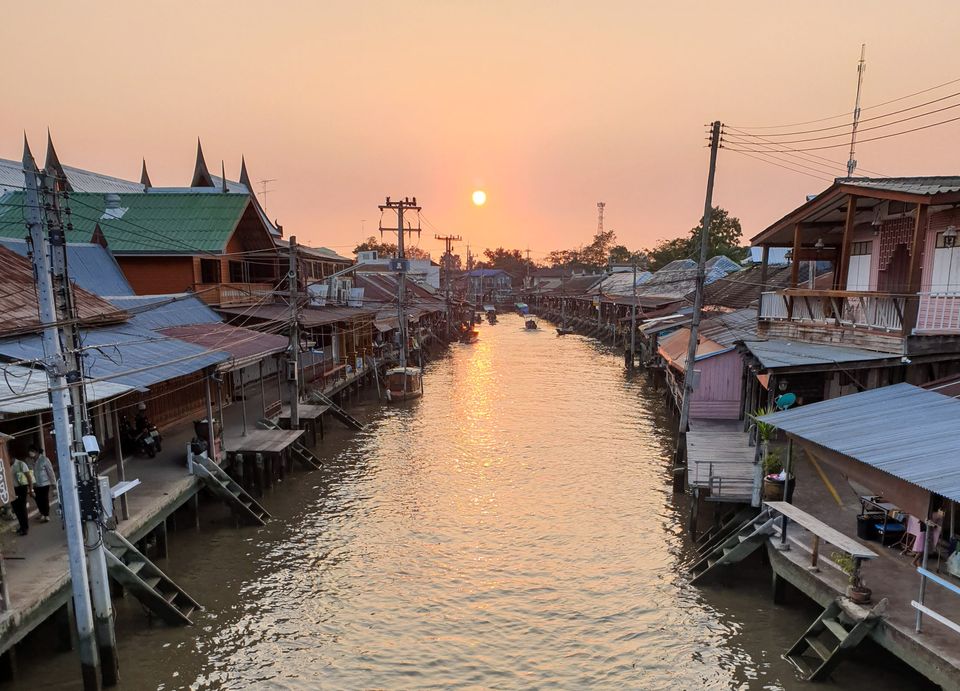
Thailand’s iconic floating markets are on the must-visit lists of many travelers. Images of vendors selling fruits and vegetables from their small boats invoke a sense of what a traditional Thai lifestyle must have been like. Most floating market tours will whisk travelers away to Damnoen Saduak Floating Market, about 1.5 hours from Bangkok. Damnoen Saduak is open daily, and it will certainly provide the photo ops that many visitors seek. But did you know that Damnoen Saduak was purpose-built in the 1970’s as a tourist attraction for foreigners? The tourism authority of Thailand repurposed a floating market that had since closed. Unfortunately Damnoen Saduak has a really touristy feel.
Just fifteen minutes away from Damnoen Saduak lies Amphawa Floating Market. This floating market is situated along a canal (called “khlong” in Thai) connected to the Mae Khlong river. Wooden stilt houses line both sides of the canal, many of which are now shops, restaurants, and guesthouses. Amphawa is the preferred floating market for domestic Thai tourists and local day trippers. As such, it’s got a very local feel and an old charm that you won’t find at Damnoen Saduak. Few foreigners seem to visit Amphawa, especially in comparison to its larger, more touristy neighbor.
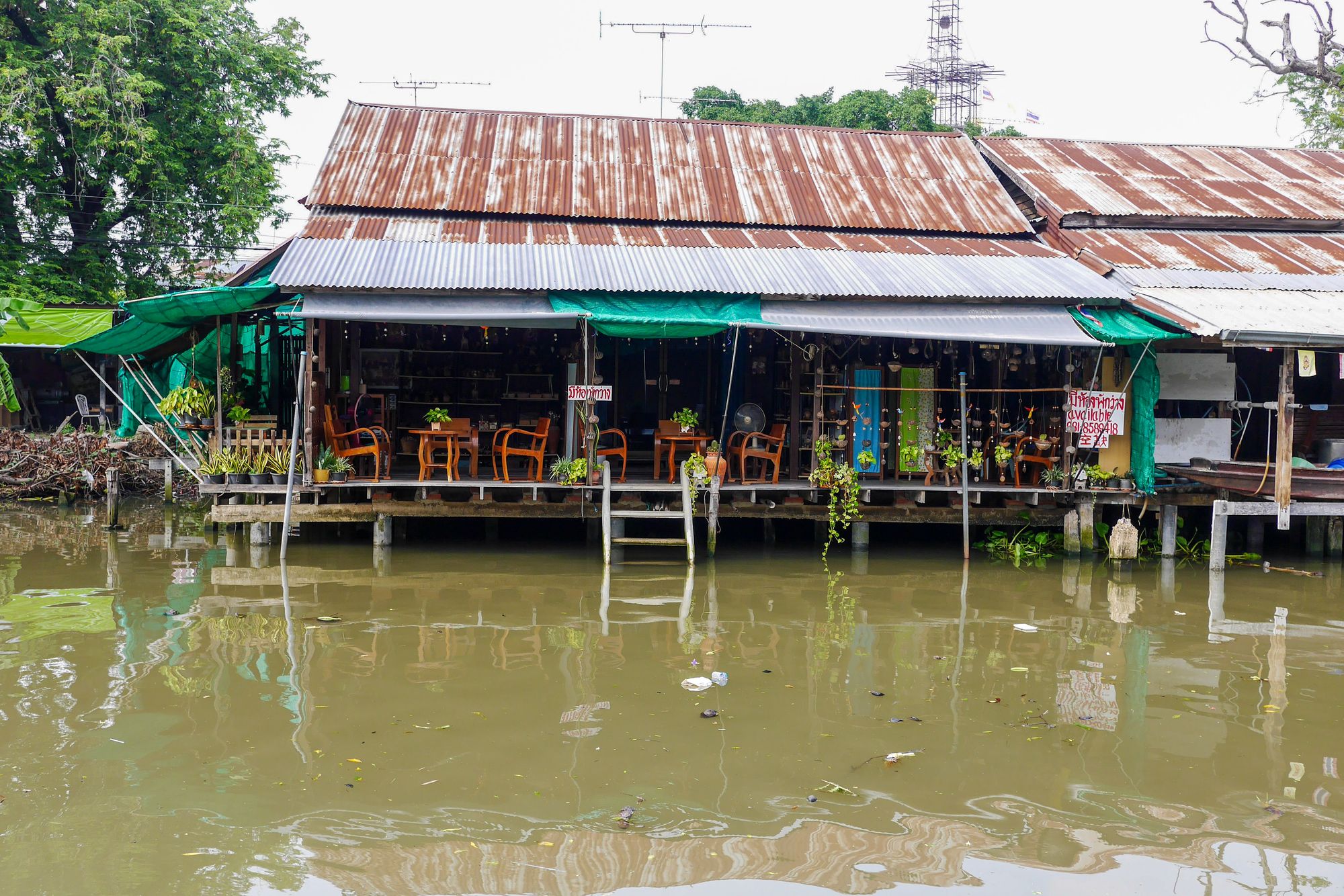
Personally, I vastly prefer Amphawa, and I have taken many guests there. Since I’ve been to Amphawa so many times, I know the ins and outs of the market. I’ll explain where to go, what to eat, and what to buy.
Atmosphere
The market stretches along both sides of a canal that empties into the Mae Khlong river. Wooden houses containing shops, restaurants, and cafes line the walkways. Several guesthouses have cafes on their ground floor, serving coffee and other drinks. Sitting down with a cold beverage is a welcome respite from the heat. There are some people selling and serving food from small boats, but the vast majority of boats will be waiting to take people on a river cruise. As you walk around, you may hear sellers politely trying to entice you to try their food or to take a boat ride with them. The scents of different dishes fill the air as you pass both seafood restaurants and general Thai food restaurants. Shops sell all manner of souvenirs, trinkets, clothing, children’s toys, and local snacks. The pedestrian bridges over the canal are built very tall to accommodate the boats. This means they have a great view, but later in the day they can get crowded with visitors snapping pictures of the market.
As the day goes on, the market will slowly fill with visitors. To enjoy a quiet stroll, walk east along the southern bank of the canal. The market will give way to private homes and a few guesthouses, where you can stroll along the waterfront in peace. If you’d like some green space, walk through Chanchala Coffee to enter the grounds of the Amphawa-Chaipattana Nurak Conservation Project, a royal project helping the local people of Amphawa.
Food
Seafood restaurants
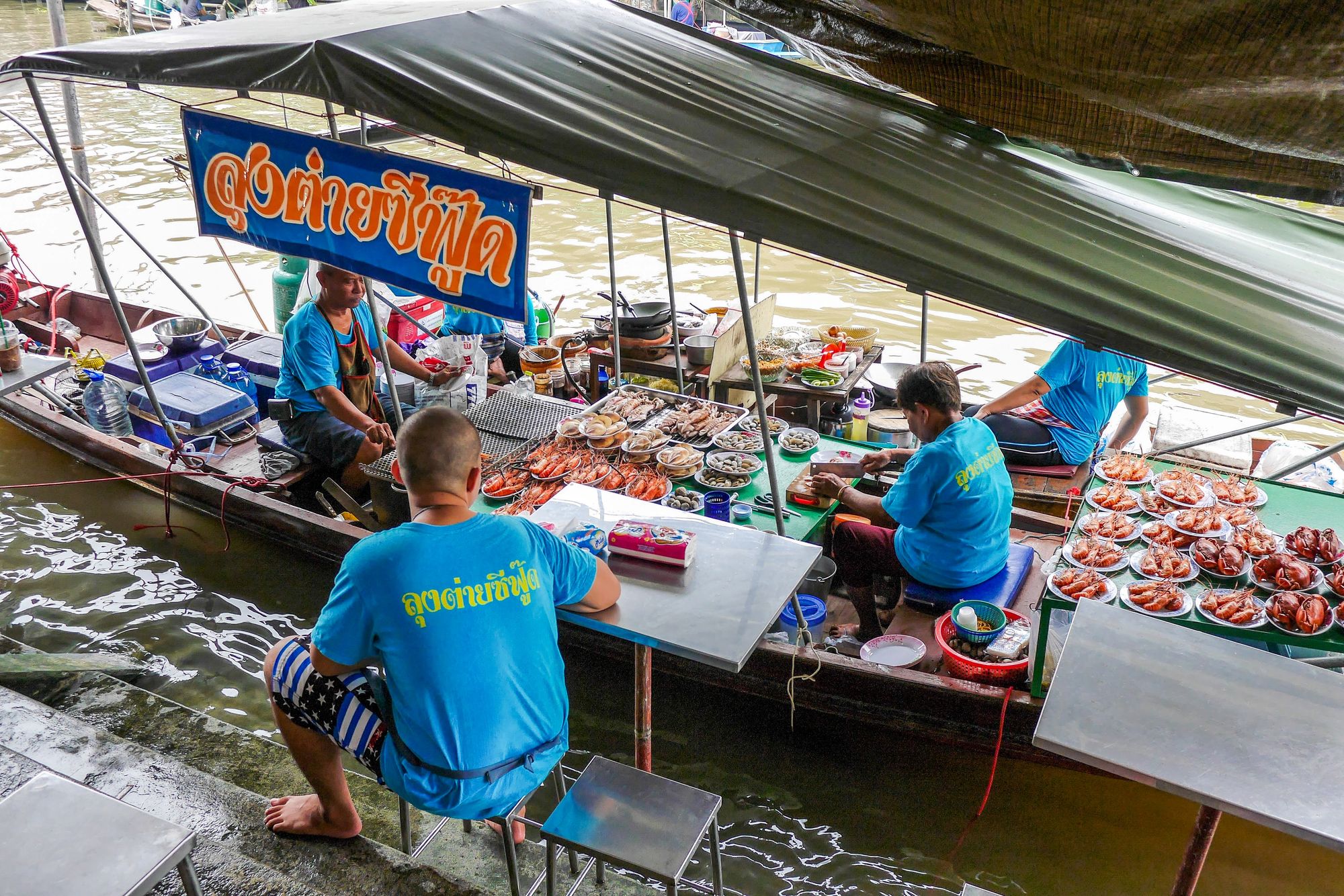
People come to Amphawa Floating Market for the seafood. You can get fish, shrimp, scallops, mussels, crab, squid, and more grilled right fresh. There is a cluster of seafood restaurants on the north bank of the canal, close to the river. Vendors will also sell grilled seafood from small boats in the canal. Many visitors love the experience of buying seafood directly from the boats. Some boats even have a few tables on the walkway where customers can enjoy their meal.
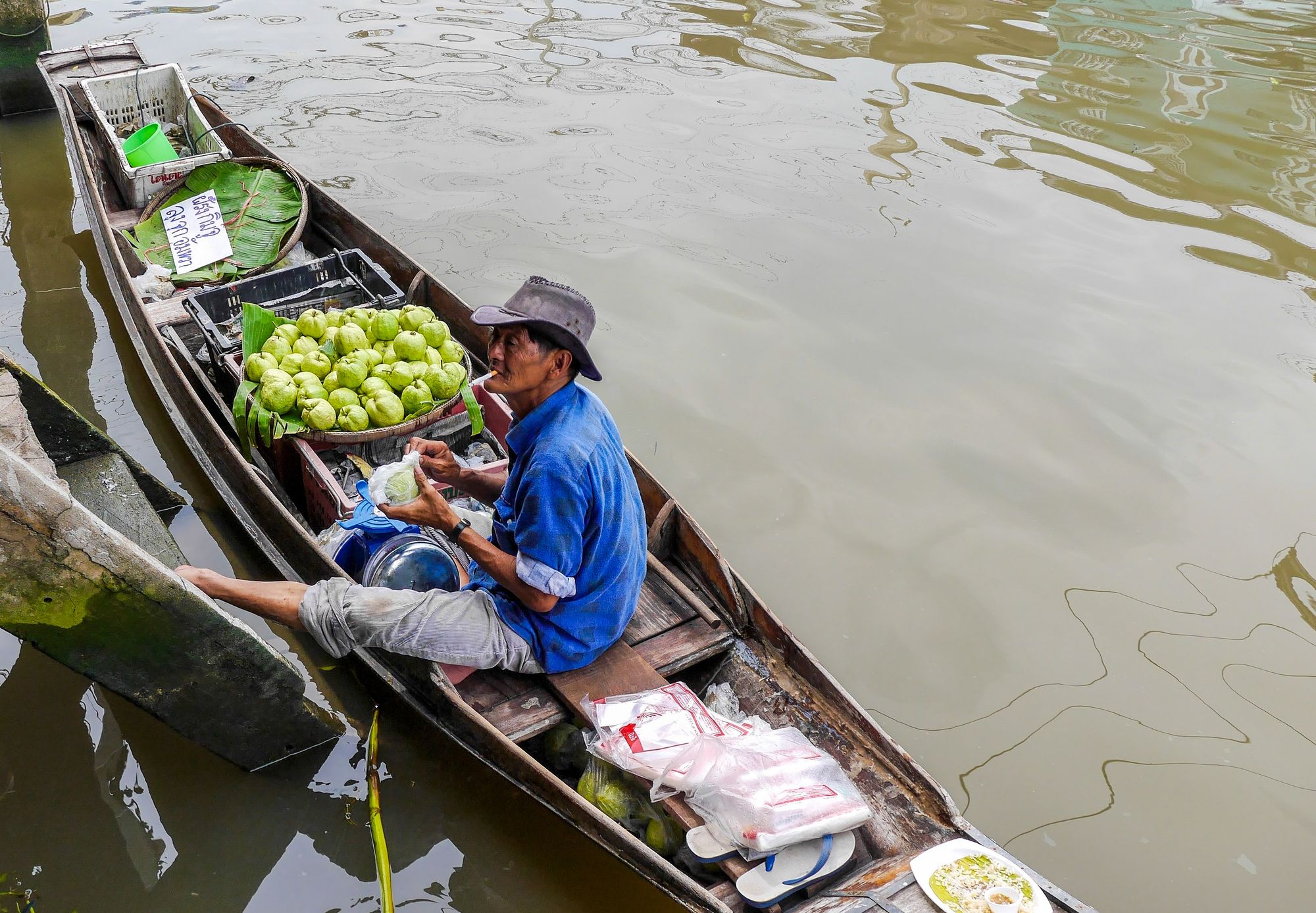
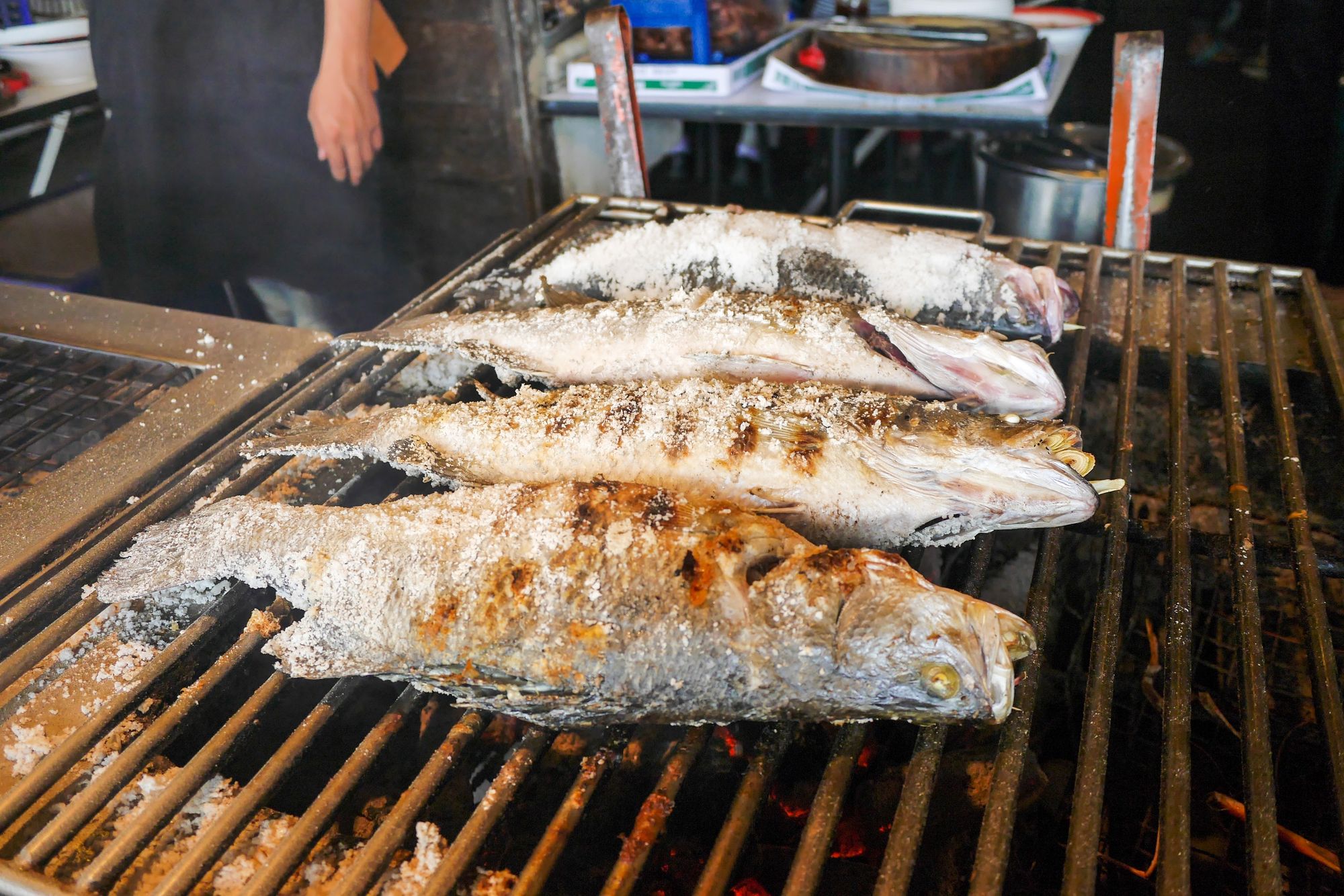
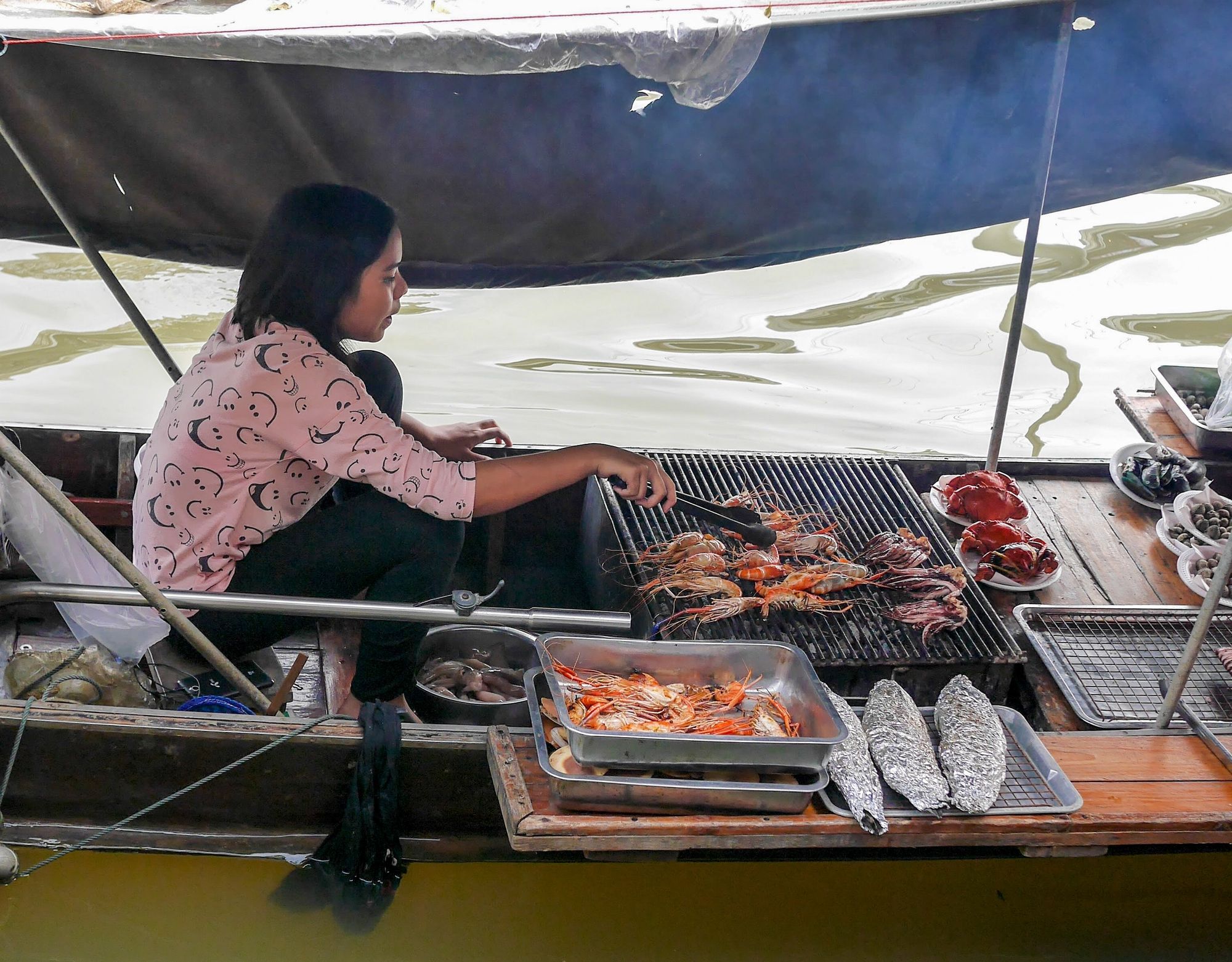
Two boat vendors and popular salt grilled fish at Amphawa Floating Market
I always recommend a visit to a restaurant in the middle of the market selling high quality seafood, grilled chicken, and other Thai dishes. This restaurant used to be called “Pawat Somtum Seafood” but is now under new ownership (As of Aug 1, 2023) and has been rebranded as “Khon Khai Kai 789” which confusingly means “chicken seller” in Thai. I just went back recently and can confirm that the food at the new restaurant tastes the same. In fact, the best way to find the restaurant is to walk along the south bank of the canal until you see a giant plastic orange chicken statue, about 6ft (1.8m) tall. That’s how you know you’ve got the right restaurant.

Despite the name and the logo, Khon Khai Kai 789 makes excellent seafood. Their tom yum goong (shrimp/prawn tum yum soup) is delicious. They get the ratio of sour to spicy right, they give a generous amount of shrimp, and the coconut-based broth is overall well balanced. My favorite dish is their sizzling garlic scallops. They use what seems like a purpose-made ceramic plate with dimples similar to an escargot dish but more shallow. They fill each dimple with one scallop and tons of chopped garlic and butter, then they set it right on the charcoal grill and will serve it to the table still sizzling. I’ve scoured the market several times for other restaurants serving this dish but I haven’t found any. They also have garlic mussels but they are served on a normal plate. Other dishes to try include the shrimp and corn somtum, salt grilled fish, crab fried rice, and of course their grilled chicken.
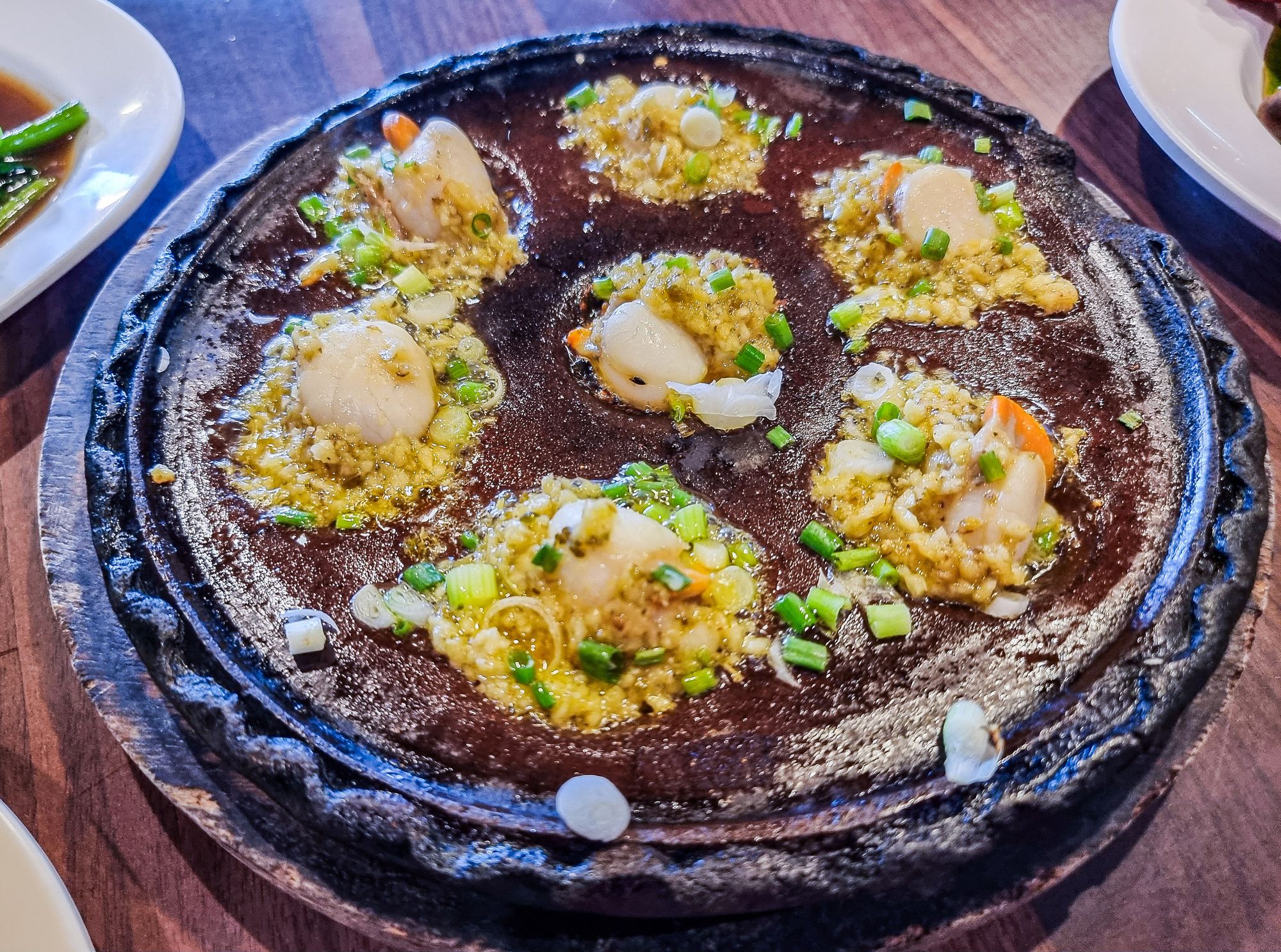
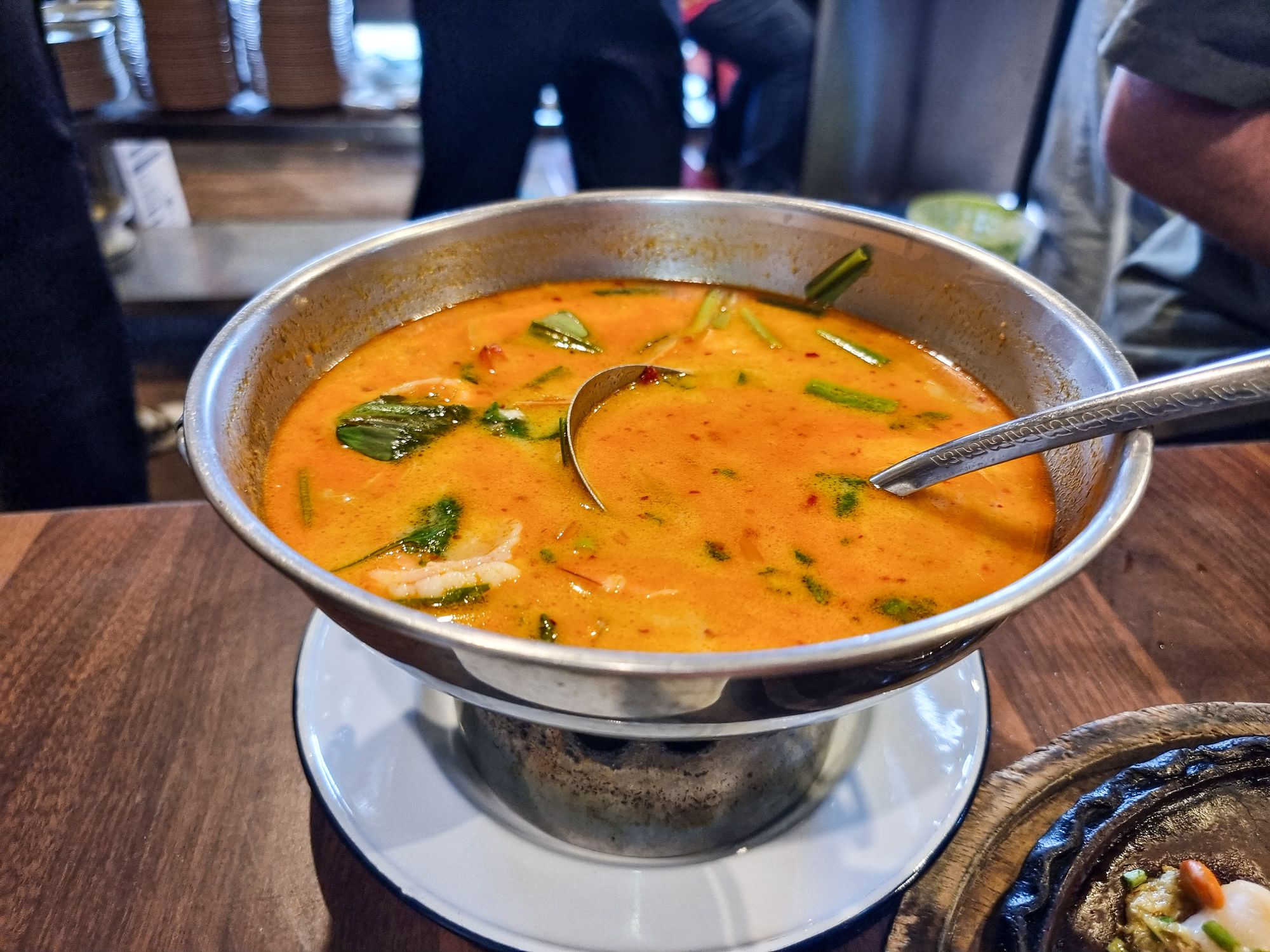
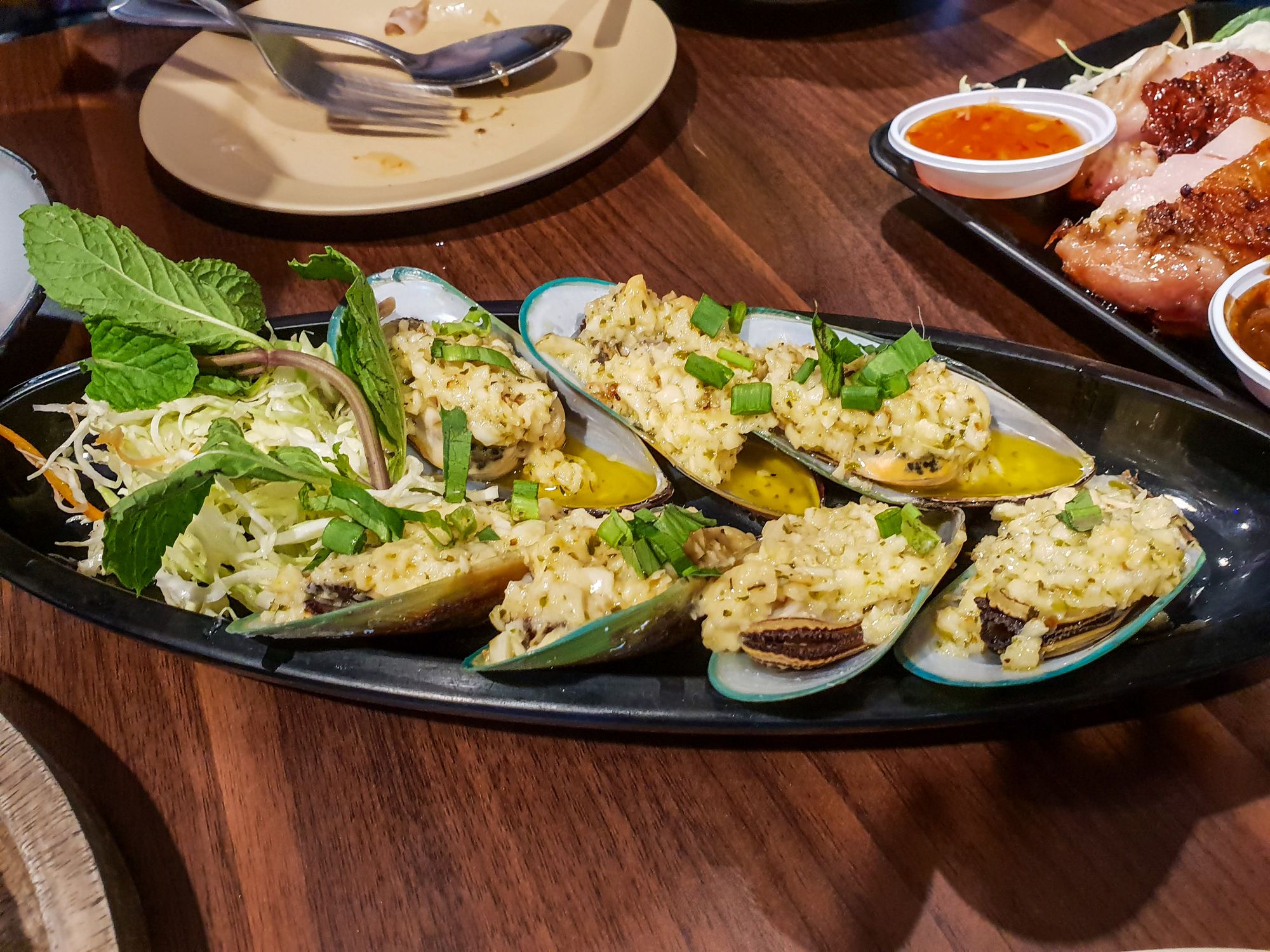
Garlic scallops, tom um goong, garlic mussels from Khon Khai Kai 789
Snacks
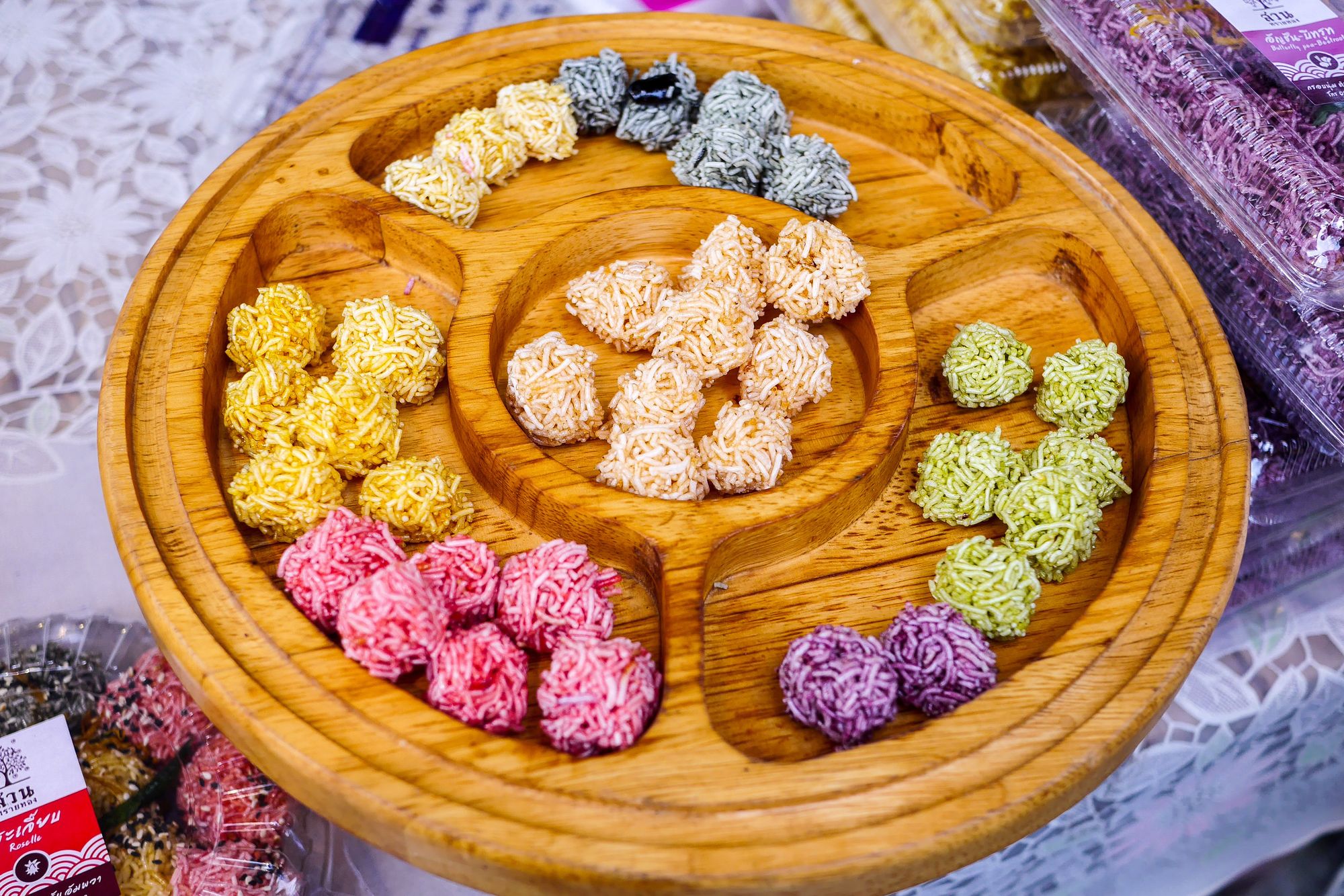
Any time you go to a local market in Thailand, you will find a lot of delicious snacks. Amphawa floating market is no different. As you walk around, don’t be afraid to try anything that looks interesting.
One snack you’ll find all over the market is mee grob, which means crispy noodles. The snack consists of crispy fried rice noodles bound together in a sticky sweet and sour sauce. Most of the vendors sell normal mee grob in snack boxes, but if you can find your way to the Amphawa-Chaipattana Nurak Conservation Project, through Chanchala Coffee, you can find a few vendors selling flavored mee grob in bright colors. Passion fruit, butterfly pea flower, pandan, berry, and other flavors.
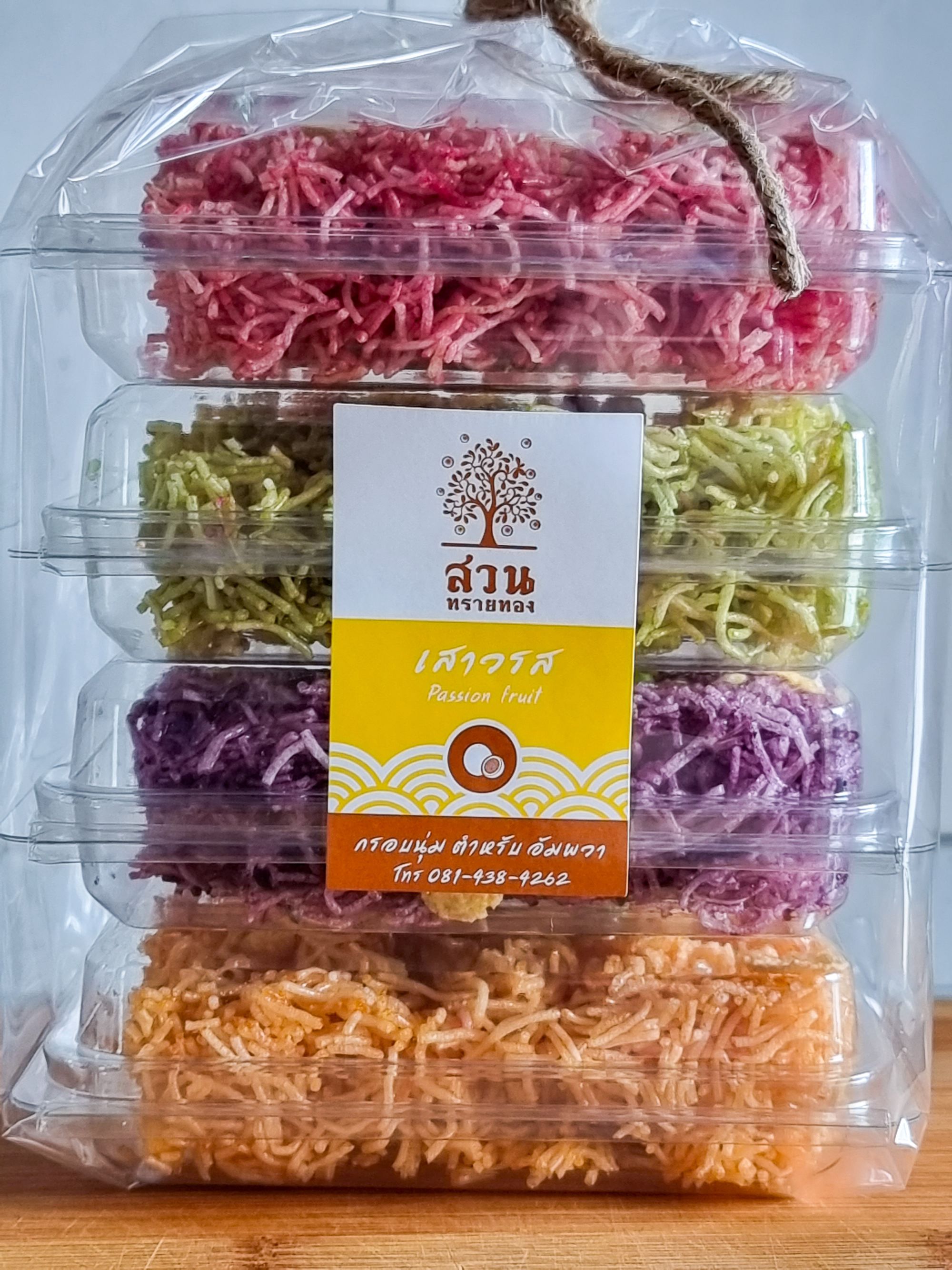
If you cross the southernmost pedestrian bridge, the market will continue down both sides of the road. There you will most likely find a vendor selling various custards in cute little ceramic containers. The yellow color ones are khanom mo gaeng (ขนมหม้อแกง), a type of egg custard. The white ones are khanom tako (ขนมตะโก้), a type of Thai pudding with a coconut cream topping. Most of the time you will see khanom tako served in a banana leaf. The use of a cute ceramic dish is creative, and you get to keep the dish. There are other khanom tako vendors in the market, and there may be other vendors selling these snacks in ceramic dishes as well.
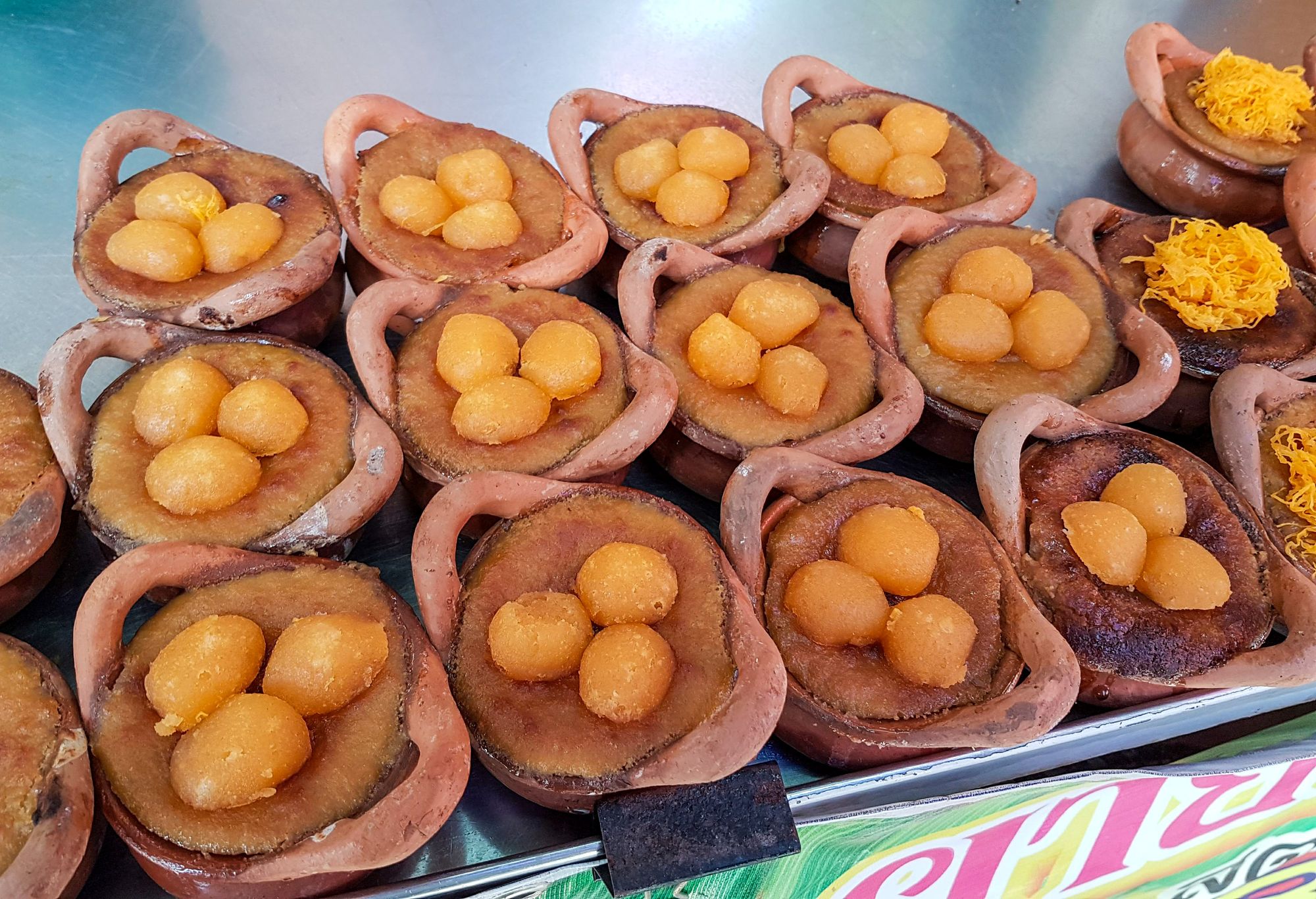
Another snack you’ll see throughout the market looks like 5 white buttons with purple underneath, on top of a banana leaf cut into a circle. These are called khanom leum kleung (ขนมลืมกลืน) - which translates to “sweet snacks I forgot to swallow”. I haven’t seen this cute formation anywhere else outside of Amphawa. A Thai friend tells me they are quite rare to find like this. The purple comes from butterfly pea flowers. If you want to try this snack, you’ll get a few stacked with your order.
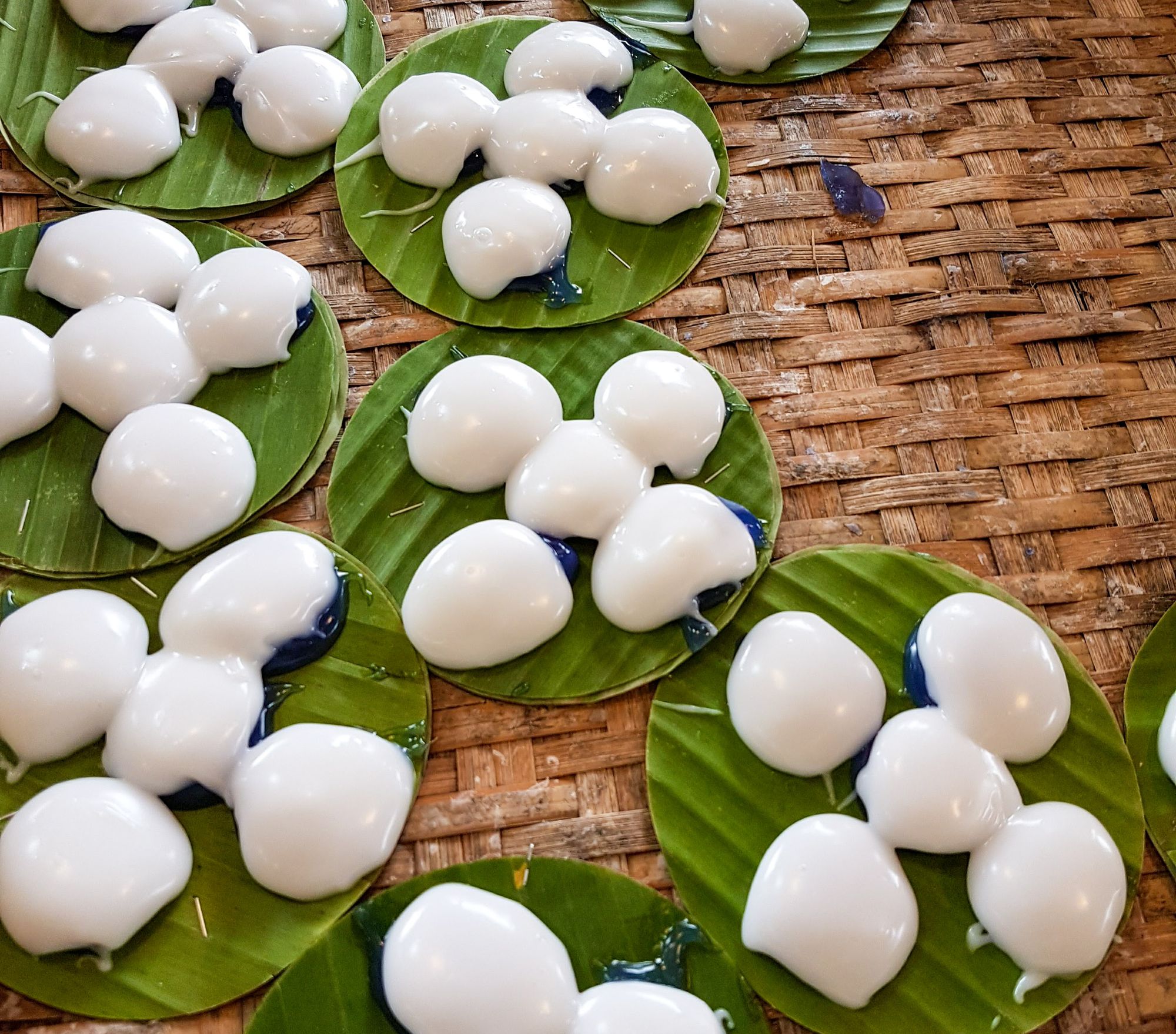
One surprising dessert you might come across at Amphawa Floating Market is the Portuguese egg tart. Did you know that the Portuguese have a long history with Thailand and were integral in influencing Thai desserts? It’s actually common to find egg tarts for sale in markets around Thailand. The ones here are quite good and I always buy a box.
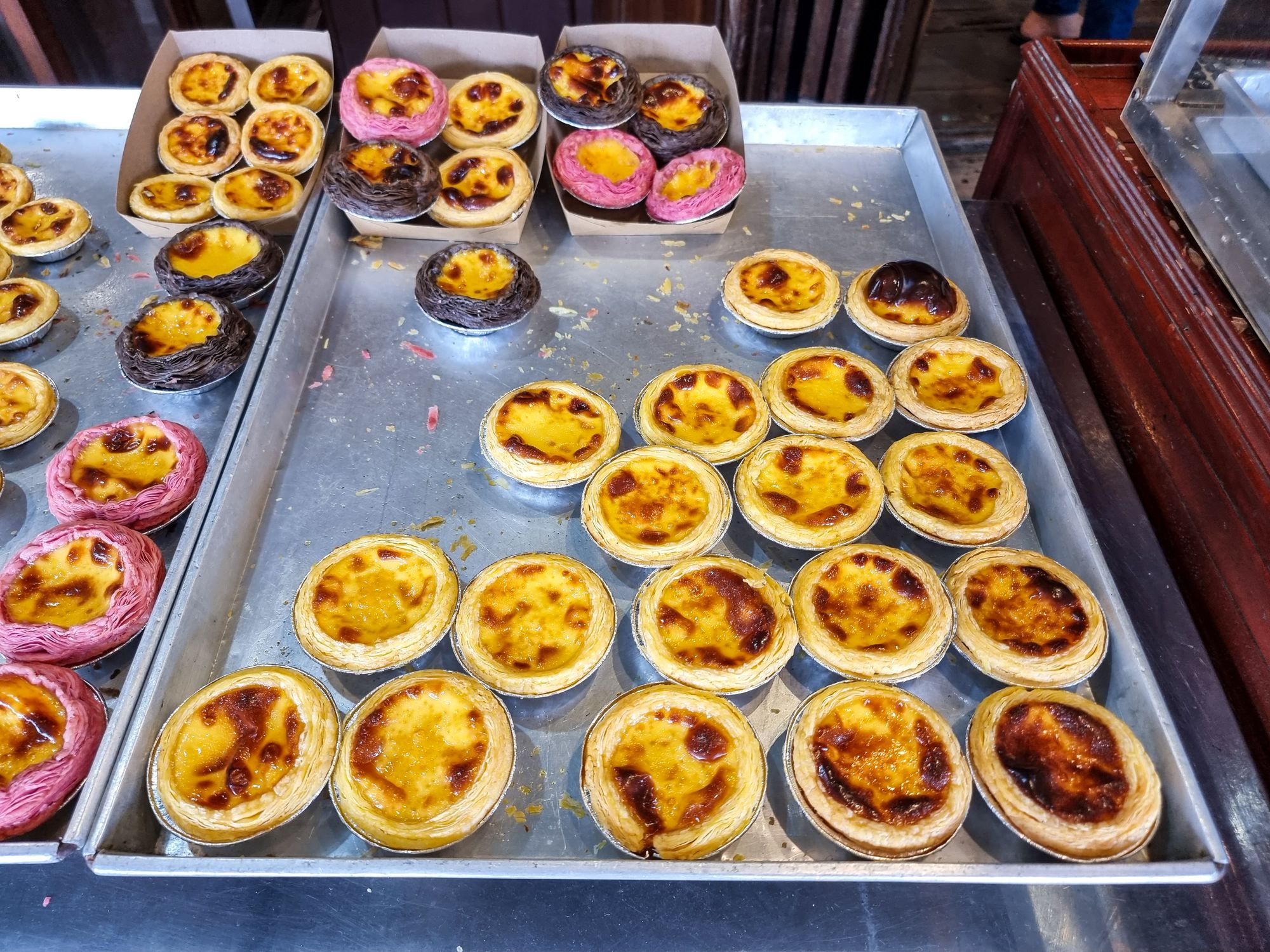
There are endless snacks to try if you want to eat your way around Amphawa Floating Market. In addition to these local delights, Thai fish cakes, quail eggs, corn on a stick, hor mok (steamed fish curry), and shumai are just some of what you will find. And if you’re craving some western comfort food, there is gelato and ice cream too. When you visit Amphawa Floating Market, make sure you arrive hungry.
Coconut Sugar
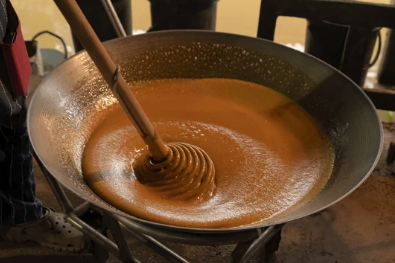
Coconut sugar is a product of Amphawa and the Samut Songkhram province. It is sold in a lot of shops at Amphawa Floating Market. In fact, there is a coconut plantation and sugar production facility within the Amphawa-Chaipattana Nurak Conservation Project, only a short walk from the main market. Here you can learn about the process of making coconut sugar.
As you walk around the market you will see shops selling two types of coconut sugar. One is soft light brown coconut sugar in round plastic take-out containers. It can be scooped out with a spoon. The other is hard light brown coconut sugar formed into small or large rounds. If I’m running low on coconut sugar, I will usually pick up a container while I’m at Amphawa.
Shopping

Most of the items for sale at Amphawa Floating Market are touristy in nature. But since Amphawa caters mainly to Thai tourists, you will find that the prices are reasonable, especially in comparison to areas that see more foreign tourists. Thus Amphawa is a good place to do your souvenir shopping. In Thailand, prices are really only overinflated in areas with high foreign tourism. They are reasonable elsewhere. It’s not typical to bargain here since you’ll be getting local prices.
If you want something special beyond just tourist souvenirs, I recommend looking around the Amphawa-Chaipattana Nurak Conservation Project. After you walk through Chanchala Coffee, there will be some handicraft vendors who also have workshops on site. You can see them working on their crafts and you can also buy something from them.
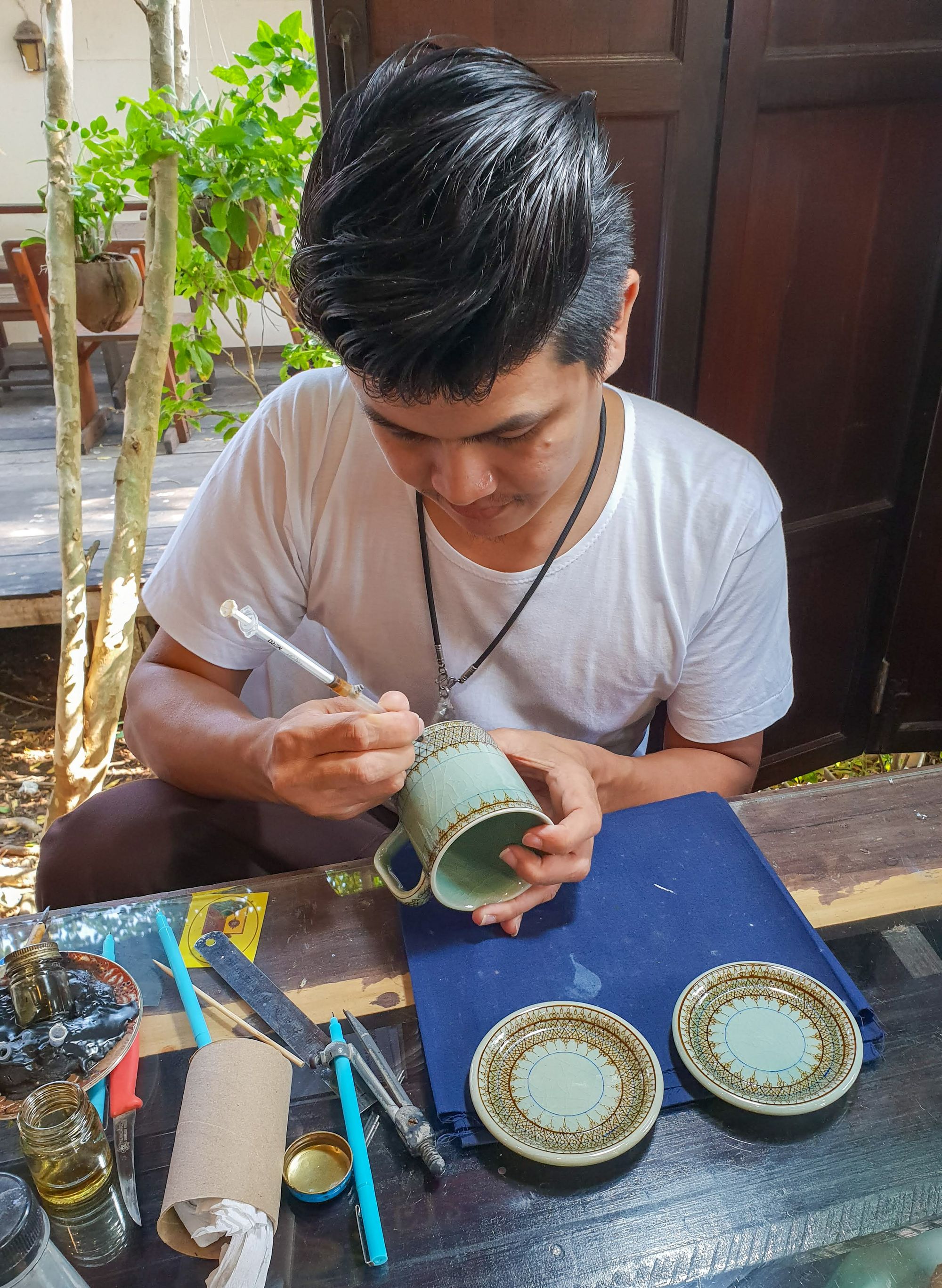
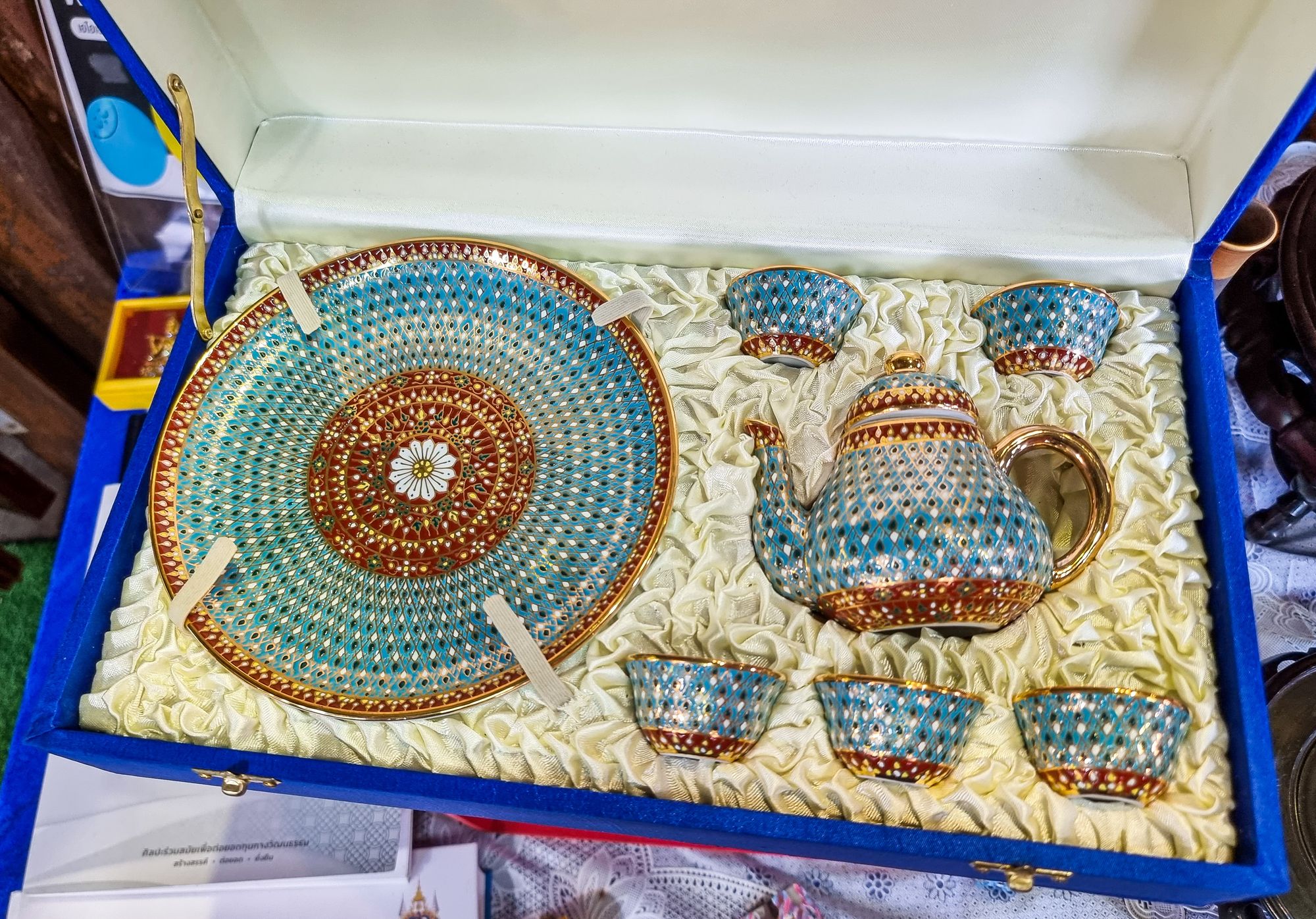
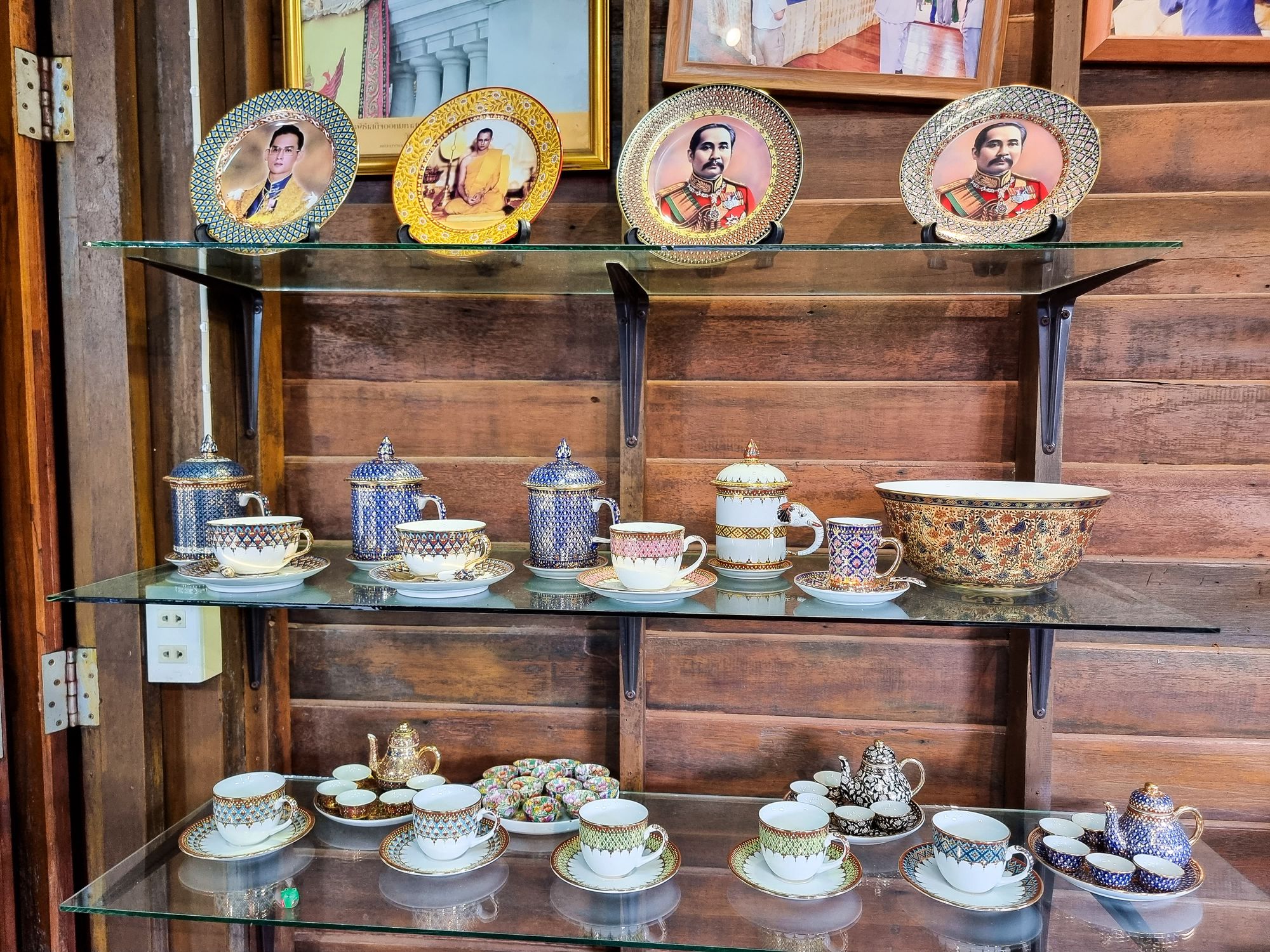
Artisan demonstrating benjarong painting and some ornately painted porcelain benjarong for sale at Thitiphan Benjarong in the Amphawa-Chaipattana Nurak Conservation Project attached to Amphawa Floating Market
I like visiting Thitiphan Benjarong. Benjarong is Thai traditional ceramic painting. Having seen a lot of benjarong, their quality is outstanding and the designs are beautiful. Sometimes you can watch them work on painting a dish or a cup in the shop. Sometimes they have workshops where people can participate in painting their own item. They produce both touristy items, like ceramic painted elephants, and expensive high quality items, like extremely ornate porcelain tea sets.
Another interesting handicraft is the carving of miniature traditional Thai houses. There is an artisan on premises who carves and sells these mini houses. There are also traditional textile vendors selling some beautiful sarongs and other clothing.
If you like shopping for souvenirs or take-home snacks, Amphawa Floating Market is a great place to do it.
Stay overnight
One thing I’ve always wanted to do is spend the night at one of the canal-side guesthouses in Amphawa. Even though a day trip is easy, the relaxing setting in a traditional wooden house seems perfect for a weekend getaway.
I haven’t stayed overnight yet, but two guesthouses I’ve considered are Thanicha Resort Amphawa and Baan Pitumata Amphawa. There are also a few others that look nice. Both Agoda and Booking.com have some properties in Amphawa.
If you want to stay overnight, make sure to book your accommodation far enough in advance, because it’s a popular weekend destination for Bangkok locals.
Timing
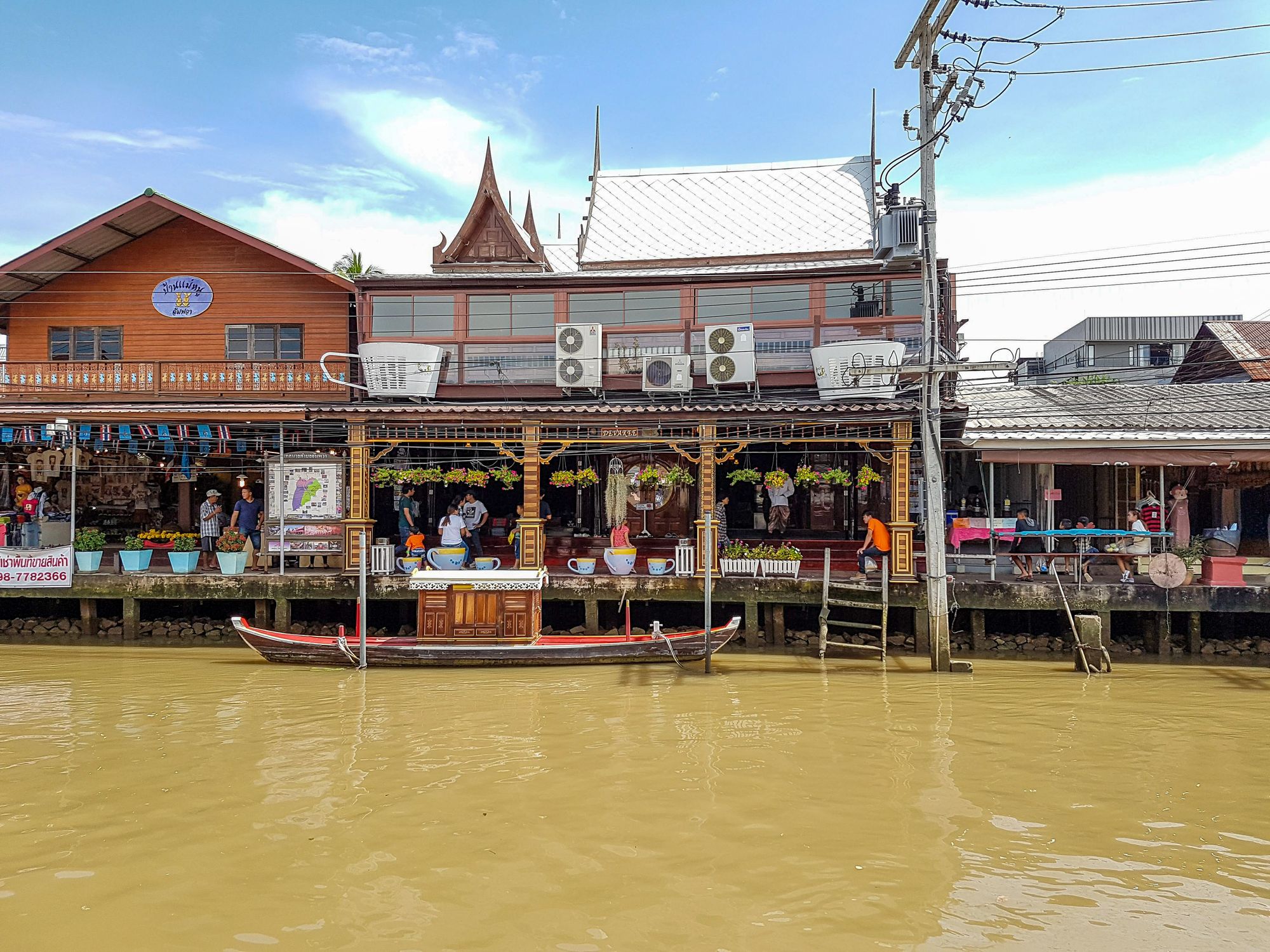
Officially the market is open Friday through Sunday from 2pm until 8pm. However I tend to go around noon on Saturdays or Sudnays and most everything is already open. Going earlier will certainly beat the crowds, but not the heat. Many people prefer to go in the evening, when the fireflies come out.
If you want to make a really long day out of floating market touring, you could conceivably go to Damnoen Saduak or another floating market in the morning and Amphawa in the afternoon. Since Amphawa is not open daily, keep Damnoen Saduak as a backup if your only free days are Mon-Thurs.
How to get there
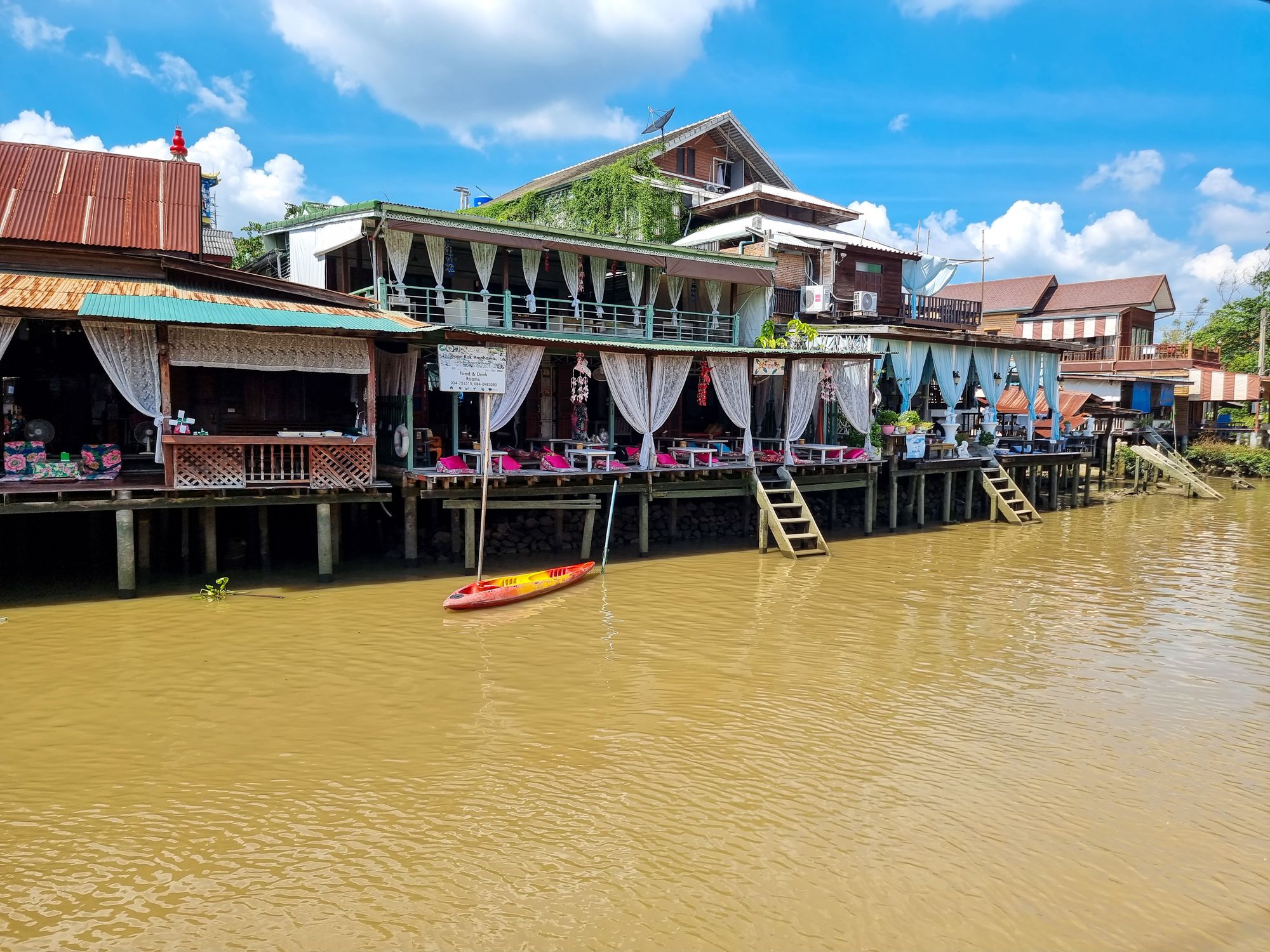
Going by car is the easiest way to get to Amphawa Floating Market. If you’re not comfortable driving, it’s easy to hire a driver for the day. Taxi Airport Bangkok has floating market day trip pricing. You can book taxis through 12Go, but they only quote for one way, so you’d have to contact the companies directly about a day trip.
Going by public transit is also possible. Mini buses depart from Victory Monument regularly. There are also regular buses to Samut Songkhram, but then you would need to find a way to the market.
Some people like to ride the train from Bangkok to the Mae Klong Railway Market. Then after visiting the market, they will catch a minibus or songtaew to Amphawa.
While most floating market tours go to Damnoen Saduak, there are definitely some tours that take visitors to Amphawa. While I can’t personally vouch for the quality of these tours since I haven't taken them, if you’re short on time or don’t want to arrange everything yourself, you can simply book a day tour to take you there. Choose one with good reviews and it should be fine.
All photos taken by me and copyright Food And Adventures, unless otherwise specified




